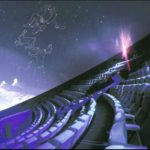In The New Horizon‘s holographic Omni-max map room, you will find all the known systems information about the Verse.
–
Table of Contents:
- Map Room Access
- Planetary Encyclopedic Database
- Solar System Catalog Database
- Conceptual Images
–
Map Room Access:
Access to the main map room aboard The New Horizon is restricted to authorized personnel. To obtain access without escort by an authorized crew member, speak to the Chief Duty Officer (CDO) or Officer of the Day (OOD) about temporary authorization.
Teams standing up to dispatch and/or deploy from The New Horizon will often have their mission briefings and After Action Reviews (AAR; a.k.a. “debriefing”) around the concave, deck-level, rotating, projector display in this room (serving as the ship’s main map table), which also extends up and around the indention, across an overhead, angled-dome ceiling.
–
Planetary Encyclopedic Database:
For simpler studies and presentations, a 2D flat-screen holograph set-up can be immediately emplaced. This is predominantly utilized for the dispersal and review of encyclopedic text-, photographic-, and video-based data on singular cosmic bodies, such as planets pending our approach and operational exposure.
The planet’s photo, description, spec’s and stat’s, as well as its human (and non-human) population, and whether or not all present sentient races are aware of one another (and to what extent) are among the common data presented when any given planet is requested. It is important to note that many of the planets, moons, and stars are hollow, and contain thriving communities and unbelievably massive ruins within; not just on the surface, or in minor frequency within cave networks close to the surface.
Microwave, resonance, and other harmonic imaging is used to update this database in real-time, upon coming within range of any cosmic body. This allows for immediate display of the current subterranean complexes networking, as well as impending tectonic and other area-effect events.
There is also a new wealth of information on the newly noticed disc-worlds forming near the surfaces of stars both young, old, dying, and recently dead (the brown dwarfs). Evidence can also be recalled of ancient wars and buried super-ships, star-destroyers and death-star class ships anchored deep inside the atmospheric levels of gas giants, and ships even found anchored inside active stars.
–
Solar System Catalog Database:
All of the star, multi-star, and proto-star systems of the colonized Verse are available for projection within this main map room. Solar systems slated for reconnaissance, terraforming, and colonization are also available for viewing, provided there is sufficient or active probe data.
The projections include data on all incidents in Deep Space and within the boundaries of each solar system which warrant further exploration, review, or inquiry, such as UFO-sightings, paranormal activity, Space-time fluctuations, gravity-rivers and gravity-undertows, etc.
Standard Operating Procedure (SOP), of course, dictates that the shipboard A.I. immediately wipe the entirety of this database at least 16 times during a ship-E.L.E. or ship-compromise event.
–
–

